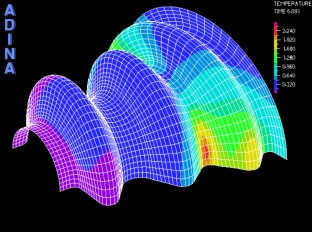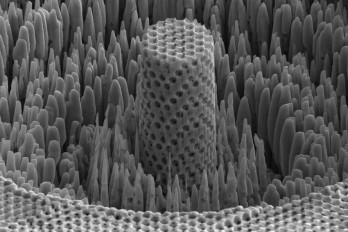Researchers use photos and new AI tool to calculate stress and strain fields of materials

Researchers at Massachusetts Institute of Technology have developed a method to determine stress and strain distributions within a material based on an image depicting its internal structure. The research team worked primarily with composite materials with both soft and brittle components and random geometrical shapes.
Original article: Massachusetts Institute of Technology. "New AI tool calculates materials' stress and strain based on photos: The advance could accelerate engineers' design process by eliminating the need to solve complex equations." ScienceDaily. www.sciencedaily.com/releases/2021/04/210427163251.htm (accessed April 27, 2021).
The research was recently published in ScienceAdvances. Zhenze Yang is the paper’s lead author and a PhD student in the Department of Materials Science and Engineering. Co-authors include former MIT postdoc Chi-Hua Yu and Markus Buehler, the McAfee Professor of Engineering and the director of the Laboratory for Atomistic and Molecular Mechanics.
The proposed approach could eventually minimize the computational needs associated with rigorous physics-based approaches, instead relying on computer vision and machine learning to generate estimates in real time.
Zhenze Yang indicated that the proposed algorithm, which uses a machine learning technique called a Generative Adversarial Neural Network, could lead to optimized design and facilitate material inspections. The researchers characteristically stated that the method “completes the whole process without any domain knowledge of physics. [] So, from a picture, the computer is able to predict all those forces: the deformations, the stresses, and so forth, that’s really the breakthrough — in the conventional way, you would need to code the equations and ask the computer to solve partial differential equations. We just go picture to picture.”
The utilized Generative Adversarial Neural Network was trained with thousands of paired images; i.e., one depicting a material’s internal microstructure subject to mechanical forces, and the other depicting that same material’s color-coded stress and strain values. Using principles of game theory, the method iteratively figures out the relationships between the geometry of a material and the resulting internal stresses.
The proposed image-based approach is particularly advantageous for complex, composite materials, where forces may operate differently at different scales, i.e., the atomic scale compared to the macroscopic scale. The developed network is adept at dealing with multiple scales since it goes through a series of “convolutions,” analyzing the images at progressively larger scales. The fully trained network performed well in experiments, successfully reproducing stress and strain values given a series of close-up images of the microstructure of various soft composite materials. The network was also able to capture cracks developing in a material, i.e., “singularities”. Within very short distances of a crack, forces and fields change rapidly. “As a material scientist, you would want to know if the model can recreate those singularities,” says Prof. Marcus Buehler. “And the answer is yes.”
Visualization of simulated failure within a composite material by a machine-learning-based approach. The red represents a soft material, white represents a brittle material, and green represents a crack. (source: MIT News)
Once trained, the network can run instantly on consumer-product-level computer processors, something that could enable engineers and inspectors to diagnose potential problems within structures by simply taking a picture.
Funding for this research was provided, in part, by the Army Research Office and the Office of Naval Research.Sources: ScienceDaily, MIT News
Want to read more like this story?
Composite structures
Sep, 07, 2023 | EducationComposite structures refer to constructions that are composed of two or more distinct materials co...

10 state-of-the-art sustainable materials that will alter construction industry
Jun, 10, 2024 | NewsIn 2024, sustainable materials become state-of-the-art in construction since the construction indus...

Sustainable materials can be used in construction to decrease environmental pollution
Apr, 30, 2024 | NewsEfforts to reduce emissions in the building sector typically focus on operational aspects like heat...

Using sophisticated material models in ADINA software
Jul, 08, 2023 | NewsSophisticated material models and reliable finite element solvers are necessary when using advanced...

Bio-inspired composite cement: a new material to increase durability using natural principles
Jun, 28, 2024 | NewsPrinceton’s university engineers developed a new composite cement inspired by oyster and abalone sh...

ADINA provides advanced material models
Aug, 01, 2023 | NewsADINA offers advanced material models in response to the need for advanced polymers in challenging...

ADINA 2025 New Release!
May, 13, 2025 | NewsBentley Systems announced a new major release of ADINA. For a complete list of changes see ADINA...

New lightweight material has the strength of titanium
Feb, 22, 2019 | NewsResearchers have developed a sheet of nickel with nanoscale pores that has the strength of titanium...

Ancient building material is re-engineered
Apr, 01, 2019 | NewsAccording to British and French scientists, cob, an ancient building material, can be re-produced wi...
Trending

Spectacular interchanges around the world

New Release - STAAD.Pro 2024 - 2

ADINA 2025 for Structural WorkSuite

Concrete Buildings as Rechargeable Batteries

Drilled Shafts Project on Gilbert Road Bridge

Powerful earthquake shakes central Philippines, dozens killed

Indonesia school collapse: three fatalities and dozens injured

